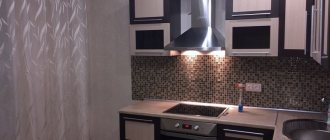Currently, technology is developing so quickly that today the concept of a comfortable home is no longer only about stylish interior design. A truly comfortable home is a smart living environment, responsive to the owner’s orders and independently maintaining the necessary parameters of the home.
Safety.
The first reason is also the most important. A smart home is safer than a regular one. We are not talking here about all sorts of spy retinal scanners and laser motion sensors. Smart home security systems include control over alarms, gas and water leakage sensors, fire protection systems and video surveillance systems.
What a smart home can do and how it works
Depending on the installed modules and configured scenarios, the possibilities of a smart home are almost limitless. Typically, basic systems include lighting and socket controls, as well as intercom and security alarm functions. More advanced complexes boast the implementation of climate and ventilation control, fire alarms, and control of water and gas leaks.
Using scripts, it's easy to set up brewing coffee in the morning, using the blinds on a sunny day, and opening the garage door when you get home. The smart home will automatically water your house plants depending on the condition of the soil, and when you leave for work, it will give the vacuum cleaner a command to clean up.
All the magic happens on the server, where data flows from hubs, to which smart home components are in turn connected.
You can control processes through a mobile application, using a universal remote control, or simply by voice using integration with Siri, Google Assistant or other virtual assistant. In this case, there are almost always duplicate mechanical buttons for manual control of devices.
Energy saving.
A smart home equipped with motion sensors and timers to automatically turn off electrical appliances allows you to save up to 40% on electricity. All temperature control systems and heated floors will be put into sleep mode every time you leave the apartment.
Popular manufacturers of ready-made Smart Home solutions
There are many models of smart home systems on the modern market. In order not to get confused in such diversity, it is important to remember the key features of the most popular brands.
Xiaomi
The set from the Chinese corporation Xiaomi includes smart sockets, security cameras, smart lamps, as well as a unit that controls all household appliances. Gadgets are connected to a mobile application, which serves as a control system. The design allows you to add up to 150 devices.
The Xiaomi system runs on the ZigBee protocol. Performance control is carried out through the Wi-Fi gateway. It is possible to connect Bluetooth elements.
Sonoff
One of the most budget options for smart home systems. All components function without reference to the central unit. The control system is replaced by one relay.
Sonoff allows you to turn sockets and lamps on and off, calculate power consumption, regulate the temperature and humidity in the room, and create a simple alarm system. All devices transmit signals to the owner’s smartphone.
Redmond
Redmond offers customers a line of smart electrical appliances, climate control and security systems. The main advantage of the devices was their ease of implementation. No intervention into the wiring or building structure is required.
The Redmond kit includes sockets, lamps, heating devices, motion sensors, surveillance cameras and other equipment. Management is also carried out using a mobile application.
Apple
Apple's smart home system runs on iPhone and iPad. The equipment offered by the company allows you to control lighting, climatic factors, multimedia equipment, and security systems.
A special feature of the set from Apple was a system for automating lawn irrigation on the site. The time to turn on and off irrigation is user programmable. Another popular gadget is the thermostatic valve. It changes the water temperature in the heating system depending on the time of day.
Huawei
The kit from the Huawei brand includes a minimum set of components. It consists of a controller, motion sensors, sensors for opening electronic locks, a temperature and air humidity sensor.
The Huawei kit allows you to connect additional modules, for example, security cameras. A smart home in an apartment can be easily adjusted to any scenario. Triggering of the door opening sensors can trigger the operation of an electric kettle or air humidification system.
Google has presented its version of a smart home in an apartment. The system consists of smart speakers that play the role of a full-fledged multimedia system. They are installed on special delivery. This design helps the owner make his life comfortable and convenient.
The smart speaker notifies you about weather changes, sets an alarm, reminds you of important tasks and dates, plays video and audio, and notifies you about calls. Google's system also includes smart plugs and lamps. Thanks to this, the speaker can automatically turn off and turn on at the right time.
Yandex.Alice
The Yandex company recently introduced Yandex Station to customers. It is an analogue of Google speakers, but is equipped with its own voice assistant, Alice. At the moment, the functionality of the system is not so wide, but this drawback is planned to be corrected soon.
Such a smart home is controlled in an apartment using voice commands. There is also a remote control. With its help, it is possible to combine the station with a TV, air conditioning and other equipment. More details about Yandex.Alice are described in the video.
Arduino
Arduino is an Italian company specializing in the development of components for smart home systems. Arduino offers equipment that you can assemble yourself without the involvement of specialists. The equipment operates on an open protocol and is compatible with most devices of other brands.
The advantage of Arduino was the ability to operate completely autonomously, a wide range of settings, as well as the affordable cost of the equipment. The kit includes sensors that monitor the climate parameters of the room, motion sensors, a thermal imager, emergency smoke and fire sensors and others.
Rubetek
Kits from Rubetek are considered one of the most affordable. Each device is accompanied by detailed instructions that allow you to install the equipment yourself.
A smart home from Rubitec controls household appliances, climate control equipment, sockets, and security cameras. It is possible to connect 300 modules. Control is carried out using a remote control or voice commands.
Schneider Electric
The Schneider company offers a system operating using KNX technology. It provides high comfort, safety and efficiency. Its main components are two buses, to which all kinds of sensors are connected.
The system is decentralized. Each node has its own controller. This ensures its reliability. If one element fails, the rest of the structure continues to function.
All in one.
Thanks to the integration of all devices into one system, any electronics in the house can be controlled using your smartphone, even from another continent. Whether it's a TV, a light bulb in the living room or a lock on the front door. All this is tied into a single management system.
What will smart homes be like in the future?
In general, the trend of smart homes has already taken shape, so we can confidently make predictions about what these systems will be like in the future. Most likely, smart homes will be available in seven to ten years:
- will receive full voice control in the most common languages;
- will control power throughout the entire house;
- will regulate heating and water supply;
- will include absolutely all consumer electronics in the house;
- will perform most of the security functions (including video surveillance);
- will replace the home personal computer, merging with it into a single whole.
Multiroom.
Forget about flash drives, cables and adapters. Watching a movie, listening to music, surfing the Internet, doing all this is much more convenient in a smart home than in a regular one. Just imagine: you turn on the player in the bedroom and go to cook in the kitchen, where you listen to the same music through the kitchen speakers.
Comfort.
Have you turned off the iron? Was the front door blocked? Was the window left open? In a smart home, such questions simply do not arise. At any time, you open the control panel on your smartphone or laptop and see all the parameters of the home control system in real time.
How to create a smart home yourself
To transform an apartment or house into the home of the future, you need smart HIPER technology. The assortment includes several dozen household appliances and accessories, from light bulbs to a dishwasher. All of them are controlled using the main hub with built-in voice assistant Alice, or from a smartphone using scripts.
The hub can be your smartphone with the Yandex application installed and the proprietary HIPER application, as well as any speaker with Alice on board.
Each HIPER accessory easily interfaces with your home Wi-Fi network through the HIPER IoT application (App Store and Google Play) on your smartphone, after which you can experiment: create your own scenarios for the actions of all devices that will be launched after pronouncing a key phrase-command to the voice assistant.
Or simply by pressing a button in the application from a smartphone from anywhere in the world.
Here is a selection of gadgets with which I recommend starting to build your own smart home.
Robot assistants.
Of course, we are still a long way from humanoid androids with artificial intelligence, although work in this direction is being carried out quite successfully. But now on the market you can find many offers of small home robots that perform certain functions. A robot vacuum cleaner, a robot cleaning the floor, a robot cleaning windows, and finally a robot that reminds you to take your medication on time or remember to go for a walk. All this is already reality.
Smart home appliances.
Of course, a smart home cannot do without appropriate household appliances. For example, refrigerators with built-in tablets for searching for recipes, online ordering products that are running out, or monitoring the expiration dates of all the products that are in it. Well, what about coffee makers that prepare coffee for you in the morning at the appointed time, or microwaves that warm up food before you get home from work?
Why do you need a smart home
Energy saving, safety and comfort are the three main goals of a smart home.
Efficient use of energy resources is achieved through the operation of lighting, climate control equipment and other equipment only in the presence of a person. Security is ensured by various sensors that detect water leaks, odors of smoke and gas, and are also capable of detecting an intrusion into the house and notifying the owner about it. Comfort is ensured by the ability to control from a smartphone and the operation of automatic scenarios.
Smart materials.
In a modern technological home, not only gadgets and household appliances can be smart, but even the walls and floor. There are already technologies that make it possible to create wallpaper that prevents electromagnetic pollution and does not allow the Wi-Fi signal to pass outside the apartment. Or, for example, window screens. Do you think this is science fiction? No, this technology was introduced back in 2012. More recently, Spanish developers presented a smart floor covering that can provide a uniform and stable Wi-Fi or Bluetooth signal throughout the entire house.
What to consider before installation: recommendations from engineers
Before creating a smart home in a new apartment, you need to decide on its feasibility and take into account the possibilities, both your own and those dictated by the environment. Before designing, the following issues are considered:
- System type. Wired or wireless. The first is appropriate if the housing is under renovation or construction. The second is recommended when a “smart home” is implemented in an already inhabited room. Compared to the wired option, installing a wireless system does not require much time and does not violate the integrity of the existing repair.
- Network protocol. Among the technologies existing on the market, the most popular are: Wi-Fi, Bluetooth Low Energy Thread, ZigBee, Z-Wave. Security is of no small importance. Based on the protocol, the appropriate hub (controller), sensors and actuators are selected.
- Users. Smart home systems use the latest technologies, which are not accessible to everyone. When implementing the system, it is necessary to take into account that among the users there will be guests or people who have little knowledge of the latest achievements of scientific life. It is desirable that the remote control be duplicated by standard switches and control systems familiar to most.
- Possibilities. A prerequisite for creating a smart home is the optimal calculation of its capabilities, i.e. the number of controlled devices and the complexity of functions. Control can be reduced to the banal switching on and off of lighting and household appliances, or it can be complicated by controlling the microclimate, switching TV channels, and programming the activation of certain devices. Insufficient number of functions, which in the future requires additional work and costs. Too sophisticated systems are used partially, which ultimately turns out to be a useless investment.
One of the most important points where to start creating home automation is drawing up a step-by-step plan. Based on it, the scale of work is assessed, existing electrical wiring and other communications are monitored. The layout allows you to avoid errors with the functionality of the equipment and the placement of controlled devices.
The main differences between a wired system and a wireless one
The advantages and disadvantages of wired and wireless Smart Home systems can be judged from the data presented in tables No. 1 and No. 2.
Tab. No. 1.
Wired
| pros | Minuses |
| Unlimited in range | Labor-intensive installation |
| High speed feedback | |
| High throughput | |
| Hacking protection |
Tab. No. 2.
Wireless
| pros | Minuses |
| Mobility, possibility of expansion without disturbing existing repairs | Limited functionality |
| Short communication range between control and executive devices | |
| High risk of outside interference | |
| Difficulties in selecting compatible devices. |
Despite the disadvantages, the wireless option is more popular, especially in apartment versions. Thanks to the improvement of technology, its disadvantages are gradually being eliminated.
Health control.
Vital sign monitoring systems can work in a single network with smart home systems. They can perform certain action scenarios. For example, a system that monitors elderly parents at home can, if one of the elderly falls, send a message about this to relatives or neighbors through the smart home hub, turn on an alarm, or send information to a doctor.
When to start designing smart home systems
A smart home technology project is a guarantee of comfort and flawless operation of far-from-cheap equipment. Ideally, planning should begin before major renovations or during the construction of a private house. Creating a smart home involves additional electrical wiring, placement of sensors, switches and actuators, which necessitates construction work.
Why is it better to implement it into a project before renovation?
In the process of creating a smart home, you have to face a lot of problems, such as:
- Partial or complete replacement of electrical wiring.
- Making changes to heat and water supply systems.
- Modernization of windows and doors, etc.
Such changes during the renovation will, at best, negatively affect the appearance of the home, and at worst, will require a major renovation of the premises.
Work related to the placement of smart home elements requires some time. Which also negatively affects the comfort of residents.
The wireless option simplifies the process somewhat. However, it also requires the installation of additional electrical wiring and installation of additional elements.
In a new apartment
The implementation of a smart home system in an apartment and a private house has a number of differences that affect the architectural, construction and operational features of residential real estate forms.
Premises in multi-apartment buildings are interconnected with each other, both by walls and utilities. A water pipe break or short circuit in one of the apartments threatens trouble for the residents of the entire house, which, when designing a smart home system, requires the introduction of appropriate safety modules, such as:
- leakage sensors;
- electrical wiring monitoring detectors;
- devices that monitor water and gas pressure;
- fire protection systems, etc.
With centralized heating, air conditioning, and ventilation, the climate control function in a “smart apartment” loses its practicality. At the same time, there is a need for backup sources of power and heat supply, which is associated with corresponding difficulties and additional costs.
A “smart apartment” does not require massive deployment of CCTV cameras. A video peephole or one video camera located on the landing is enough.
In a private house
A private “smart home” offers greater capabilities, but requires a larger number of sensors and modules. Security systems mean covering more space than in an apartment. Control of entrance and garage doors is added to the opening of entrance doors. Unlike apartments, the creation of backup power sources in private households does not create problems and does not cause complaints from utility services.
Almost any household electrical appliance turns into a “smart” one by pairing it with an appropriate gateway.
Problems of implementing systems in residential premises
The construction of smart houses in habitable premises is complicated by existing communications and interior items. If moving furniture is not considered a serious problem, then laying new electrical cables, installing air conditioners and heaters will turn a habitable room into a construction site and in the future will come down to another major renovation.











